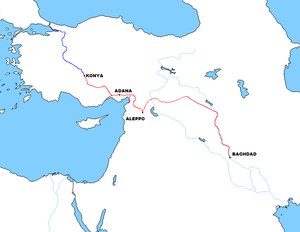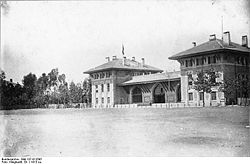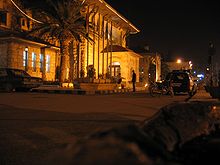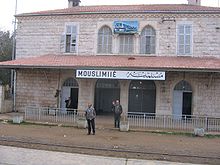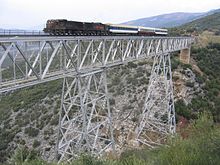- Baghdad Railway
-
Chemin de Fer Impérial Ottoman de Baghdad
CIOB in red (CFOA route to İstanbul in blue)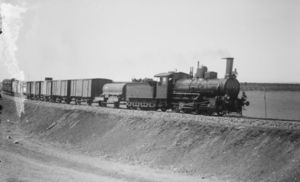
Baghdad railway circa 1900-1910Reporting mark CIOB Locale Southeastern Turkey, Dates of operation 1904–1921 Successor TCDD, CNS Track gauge 4 ft 8 1⁄2 in (1,435 mm) (standard gauge) Headquarters Adana The Baghdad Railway (Turkish: Bağdat Demiryolu, German: Bagdadbahn, French: Chemin de Fer Impérial Ottoman de Baghdad), was built from 1903 to 1940 to connect Berlin with the (then) Ottoman Empire city of Baghdad with a 1,600 kilometres (990 mi) line through modern-day Turkey, Syria, and Iraq.
Funding and engineering was mainly provided by German Empire banks and companies, which in the 1890s had built the Anatolian Railway (Anatolische Eisenbahn) connecting Istanbul, Ankara and Konya. The Baghdad Railway was to connect Berlin with Baghdad, where the Germans wanted to establish a port in the Persian Gulf.[1] The Ottoman Empire desired to maintain its control of Arabia and to expand its influence across the Red Sea into the nominally Ottoman (until 1914) Khedivate of Egypt, which was militarily controlled by the United Kingdom since the Urabi Revolt in 1882. The Germans gained access to and ownership of oil fields in Iraq, and with a line to the port of Basra would have gained better access to the eastern parts of the German colonial empire, bypassing the Suez Canal.
The railway became a source of international disputes during the years immediately preceding World War I. Although it has been argued that they were resolved in 1914 before the war began, it has also been argued that the railway was a leading cause of the First World War.[2] Technical difficulties in the remote Taurus Mountains and diplomatic delays meant that by 1915 the railway was still 480 kilometres (300 mi) short of completion, severely limiting its use during the war in which Baghdad was occupied by the British while the already completed Hejaz railway in the south was attacked by guerrilla forces led by T. E. Lawrence. Construction resumed in the 1930s and was completed in 1940.
A history of this railway in the context of World War I history has lately emerged to describe the German interests in countering the British Empire, and Turkey's interest in countering their Russian rivals.[3] As stated by a contemporary 'on the ground' at the time, Jastrow wrote [4] "It was felt in England that if, as Napoleon is said to have remarked, Antwerp in the hands of a great continental power was a pistol leveled at the English coast, Baghdad and the Persian Gulf in the hands of Germany (or any other strong power) would be a 42-centimetre gun pointed at India."
Contents
Overview
If it had been completed earlier, the Berlin-Baghdad (and, ultimately, Basra) railway linkages would have enabled transport and trade from Germany through a port on the Persian Gulf, from which trade goods and supplies could be exchanged directly with the farthest of the German colonies, and the world. The journey home to Germany would have given German industry direct supply of oil. This access to resources, with trade less affected by British control of shipping would have been beneficial to German economic interests in industry and trade,[5] and threatening to British economic dominance in colonial trade.
The railway also threatened Russia, since it was accepted as axiomatic that political influence followed economic, and the railway was expected to extend Germany's economic influence towards the Caucasian frontier and into north Persia where Russia had a dominant share of the market.[6]
By the late 19th Century the Ottoman Empire was weak, and cheap imports from industrialised Europe and the effects of a disastrous war had resulted in the country's finances being controlled by the Ottoman Public Debt Administration, composed of and answerable to the Great Powers.[7] The Europeans saw great potential to exploit the resources of the weakening empire, irrigation could transform agriculture, there were chrome, antimony lead and zinc mines and some coal. Not least there was potentially vast amounts of oil.
As early as 1871 a commission of experts studied the geology of the Tigris and Euphrates rivers and reported plentiful oil of good quality, but commented that poor transportation made it doubtful these fields could compete with Russian and American ones. During 1901 a German report announced the region had a veritable "lake of petroleum" of almost inexhaustible supply.[8]
In 1872 German railway engineer Wilhelm von Pressel was retained by the Ottoman government to develop plans for railways in Turkey. However, private enterprise would not build the railway without subsidies, so the Ottoman Government had to reserve part of its revenues to subsidise its construction, thus increasing its debt to the European powers.[9]
The process of construction of a rail line from İstanbul to Baghdad begun during 1888 when Alfred von Kaulla, manager of Württembergische Vereinsbank, and Georg von Siemens, Managing director of Deutsche Bank, created a syndicate and obtained a concession from Turkish leaders to extend the Haydarpaşa - İzmit Railway to Ankara. Thus came into existence the Anatolian Railway Company (SCFOA, or ARC).[10]
After the line to Ankara was completed during December 1892, railway workshops were built in Eskişehir and permission was obtained to construct a railway line from Eskişehir to Konya, and that line was completed in July 1896.[11] The two lines were the first two sections of the Baghdad Railway. Another railway built at the same time by German engineers was the Hejaz railway, commissioned by Sultan Hamid II.
The Ottoman Empire chose to place the line outside the range of the British Navy guns. Therefore, the coastal way from Alexandretta to Aleppo was avoided. The line had to cross the Amanus mountains inland at the cost of expensive engineering including an 8 km tunnel between Ayran and Fevzipaşa.[12]
The Baghdad Concession
During 1898 and 1899 the Ottoman Ministry of Public Works received many applications for permission to construct a railway to Baghdad, it was not because of lack of competition that the Deutsche Bank was finally awarded the concession. A Russian plan was rejected for fear of it extending Russian influence in Constantinople. A well-financed British plan collapsed due to the outbreak of the Boer War. A well-financed French proposal entitled the Imperial Ottoman Railway[13] enabled them to become financiers of the winning Deutsche Bank plan.[14]
Other nations of Europe paid little attention to the building of the railway lines until 1903 when the Ottoman Government gave permission to an Ottoman corporation to build the railway line from Konia to Baghdad. This Baghdad Railway Company was controlled by a few German banks. McMurray rejects the theory that the railway tied Turkey to Germany.
There was concern in Russia, France, and Britain after 1903 as the implications of the German scheme to construct a great Berlin-Baghdad railway became apparent. A railway that would link Berlin to the Persian Gulf would provide Germany with a connection to its southernmost colonies in Africa, i.e. with German East Africa (present-day Rwanda and Burundi and the mainland part of Tanzania) and German South-West Africa (present-day Namibia, less Walvis Bay). The railway might eventually have strengthened the Ottoman Empire and its ties to Germany and might have shifted the balance of power in the region.
Despite obstructions at the diplomatic level, work slowly began on the railway. Both geographical and political obstacles prevented the completion of the Baghdad Railway before World War I commenced in 1914.
Route
The railway passed through the following towns and places, in the order given, north to south:
- Konya
- Anatolian table lands
- Karaman
- Ereğli
- The foothills of Taurus
- Gülek Pass
- Çukurova plain
- Yenice
- Adana
- Amanus range
- Aleppo
- Nusaybin
- Mosul
- Baghdad
- Basra
The line Mersin–Yenice–Adana existed prior to the construction of the Bagdad railway and was used for the later in its section Yenice–Adana.[15]
British view of the railway
The initial reaction of Britain was one of strong support. A long article outlining the positive benefits of the enterprise appeared in the Times newspaper. It was argued that Germany was a major trading partner of Britain, and that though the competition for trade would affect Britain the fact that it was a good trading partner that was winning the trade instead would make up for the loss.[citation needed]
The railway would obviously compete with British trade in Mesopotamia, but this would not happen for many years. However in 1906 the Hamburg-American Steamship Line announced its intention to run regular steamships between Europe and the Persian Gulf. After a futile price war the British lines, which had lost their monopoly, came to agreement in 1913 with their competitors, ending a rivalry which had caused considerable political concern.[16]
In 1911 the railway company looked to build a branch line to Alexandretta from Aleppo to pick up on the valuable trade of Northern Syria and the Northern Mesopotamian valley. However the Young Turk government could not offer further railway concessions without raising customs duties from 11 to 14 percent. Such a raise required the agreement of all the powers, but was vetoed by Britain after Sir Edward Grey spoke in the House of Commons—"... if the money is to be used to promote railways which may be a source of doubtful advantage to British trade ... I say it will be impossible for us to agree to that increase ...".[17]
The British realised that the railways would be slightly too close to their oilfields in Persia. The British were worried that the Young Turks could block off oil supplies vital for the navy.
The main British commercial interest that the British government insisted was protected, was that of the Right Honorable James Lyle Mackay, Baron Inchcape of Strathnaver. As well as being the foremost shipping magnate of the British Empire, Lord Inchcape was a director of the Anglo-Persian Oil Company and of the D'Arcy Exploration Company. On February 23 a contract was signed in London between Lord Inchcape and the Baghdad Railway Company.[18] In March 1914 the German government was obliged to recognize southern Mesopotamia, as well as central and southern Persia, as the exclusive field of operations of the Anglo-Persian Company.[19]
Role in origins of World War I
Discussion of the railway's role as a contributing factor to the outbreak of war is complicated by two issues:
Firstly, historians and political analysts who wrote about this issue directly after the war were not in possession of closed diplomatic records. Full diplomatic documents of the German government were released between 1922 and 1927, British documents between 1926 and 1938. Only some Russian documents were released, and Italian documents only came out after the Second World War.[20]
Secondly, war historians tend to give an interpretation of the facts that is clouded by their own partisanship, political orientation, language, and contemporary perspectives. Socialist historians emphasised imperial rivalries and economic monopolies as the driving force for the war, as was popularly reported with respect to the railway at the time[21] and especially as revealed in the Russian diplomatic documents. Regardless of diplomacy, financing and agreements, and later points of view, the existence of the railway would have created a threat to British dominance over German trade, as it would have given German industry access to oil, and a port in the Persian Gulf. The importance of oil as opposed to coal as fuel was recognised, as it could greatly improve the performance and capacity of the rival navies. The presence of the British there, and the creating of Kuwait to block non-British access to the Persian Gulf speaks to the strategic importance.
Other historians have argued that intractable nationality issues in the denial of self-determination to minority groups were among the dominant causes of World War I.[22] They argue that although the railway issue was heated before 1914 (Corrigan shows that the railway issue was driving Germany and Turkey further apart) conservative historians agree that it was not a cause of World War I,[23] because the main controversies (over financing) had been resolved before the war started.
"Some of the optimism should be attributed to the willingness of the German government to compose long-standing differences... and in June 1914 a settlement was achieved over the Baghdad railway." (Evans)[24]
"Many economic and colonial issues which had been causing friction between French, German and British governments before 1914, such as the financing of the Berlin-Baghdad railway and the future disposition of the Portuguese colonies, had been resolved by the summer of 1914." (Henig)[23]
However, war began on August 1, 1914 — and one day later the secret treaty establishing the Ottoman-German Alliance was signed, perhaps giving credence to the notion that the issue had not been fully resolved. In fact, restriction of German access to Mesopotamia and its oil, and strategic exclusion from rail access to the Persian Gulf was enforced by British military presence during World War I, and afterwards by removal of the would-be Baghdad Railway from German ownership. Thus the potential consequences to Anglo-German economic rivalry in oil and trade by the existence of the railway, rather than the financing of it is seen by some as the deeper issue.[25]
During the War
By 1915, the railway ended some 50 miles east of Diyarbakır. Another spur, heading east from Aleppo, ended at Nusaybin. Additionally some rail was laid starting in Baghdad reaching north to Tikrit and south to Kut. This left a gap of some 300 miles between the railway lines. Additionally, there were three mountains which the railway was going to go through, but the tunnels through these three mountains were not complete. So the railway was, in fact, broken into four different sections at the start of the war. The total time to get from Istanbul to Baghdad during the war was 22 days.[26] The total distance was 1,255 miles (2019 km).
The breaks in the railway meant that the Ottoman government had significant difficulties in sending supplies and reinforcements to the Mesopotamian Front. The fighting in Mesopotamia remained somewhat isolated from the rest of the war. During the conflict, Turkish and German workers laboured to complete the railway for military purposes but with limited manpower and so many more important things to spend money on, only two of the gaps were closed.
After the war
In 1919, the Treaty of Versailles cancelled all German rights to the Baghdad Railway. However, the Deutsche Bank transferred its holdings to a Swiss bank.
People in Turkey, Italy, France, and Britain created various arrangements that gave a certain degree of control over the Baghdad Railway to various indistinct interests in those nations. Investors, speculators, and financiers were involved by 1923 in secretive and clandestine ways.
The British Army had completed the southeastern section from Baghdad to Basra, so that part was under British control. The French held negotiations to obtain some degree of control over the central portion of the railway, and Turkish interests controlled the oldest sections that had been constructed inside of Turkey, but talks continued to be held after 1923. The United States involvement in the Near East began in 1923 when Turkey approved the Chester concession, which aroused disapprovals from France and the United Kingdom.
In 1930, a passenger service by road was introduced to bridge the missing section of line between Nusaybin and Kirkuk. At different times the service used Rolls-Royce cars and Thornycroft buses.
In 1932, the Kingdom of Iraq became independent from the UK. In 1936, Iraq bought all railways in its territory from the UK and started building the missing section of line from Tel Kotchek to Baiji.[27] On July 15, 1940, the railway had been completed and two days later the Taurus Express made its first complete journey between Istanbul and Baghdad. In that year, the Robert Stephenson and Hawthorns locomotive works in Britain built a class of streamlined pacific steam locomotives to haul the Taurus Express between Baghdad and Tel Kotchek. These were delivered to Iraqi State Railways in 1941 and entered service as the PC class.[28]
A new standard gauge railway opened between Baghdad and Basra for freight traffic in 1964 and for freight in 1968.[29] This replaced a metre gauge line built in 1920 and for the first time connected the Bosporus with the Persian Gulf without a break of gauge. Due to the strained relations between Turkey, Syria and Iraq however, continuous traffic remained rare, and other means of transport soon reduced its strategic and economic relevance.
Current situation
Most of the line is in a usable condition. Robinson's World Rail Atlas shows it as intact.[30]
Most of the stations are still original.
The part between Toprakkale and Narlı has been electrified for heavy ore transport.
On February 16, 2010, the link between Mosul and Gaziantep was reopened. The first train went from Mosul to Gaziantep, lasting 18 hours. On February 18, a return journey will depart from Gaziantep to Mosul.[31][32] This line has now closed once again.[33]
Bibliography
- Mehmet Besirli: Die europäische Finanzkontrolle im Osmanischen Reich der Zeit von 1908 bis 1914. Die Rivalitäten der britischen, französischen und deutschen Hochfinanz und der Diplomatie vor dem ersten Weltkrieg am Beispiel der türkischen Staatsanleihen und der Bagdadbahn. Berlin 1999.
- Benno Bickel: Mit Agatha Christie durch die Schluchten des Taurus. Die Bagdadbahn im Spiegel der Literatur und des Reiseberichts, in Jürgen Franzke (Hrsg.): Bagdadbahn und Hedjazbahn. Deutsche Eisenbahngeschichte im Vorderen Orient. Nürnberg 2003, pages 120-124. ISBN 3-921590-05-1
- Benno Bickel: Zeittafel Bagdadbahn, in: Jürgen Franzke (Hrsg.): Bagdadbahn und Hedjazbahn. Deutsche Eisenbahngeschichte im Vorderen Orient. Nürnberg 2003, pages 160-162. ISBN 3-921590-05-1
- H. S. W. Corrigan, "German-Turkish Relations and the Outbreak of War in 1914: A Re-Assessment". Past and Present, No. 36 (April, 1967), pp. 144–152.
- Jgnaz Civelli: Deutsche Schienen in osmanischem Boden. Eine virtuelle Reise mit der Anatolischen und Bagdadbahn durch Geschichte, Wahrnehmungen, Raum und Zeit. Fachbuch, 266 Seiten. Zofingen / Zug 2010. ISBN 978-3-640-59495-5.
- R. J. W. Evans (British) and Hartmut Pogge Von Strandman (German), The Coming of the First World War - Oxford UP 1990.
- E. M. Earle Turkey, The Great Powers, and the Bagdad Railway. Russel and Russel (1923; reprint: 1966).
- Peter Heigl, Schotter für die Wüste. Die Bagdadbahn und ihre deutschen Bauingenieure, Nürnberg 2004. ISBN 3-00-014268-1
- Hugh Hughes, Middle East Railways Harrow, The Continental Railway Circle, 1981. ISBN 0-9503469-7-7
- Morris Jastrow, Jr., The War and the Bagdad Railway. 1917. ISBN 1402167865 (electronic copy)
- William Engdahl, A Century of War: Anglo-American Oil Politics and the New World Order. ISBN 0-7453-2310-3
- Ruth Henig, The Origins of the First World War. Routledge. 1989, 2nd edition: 2002.
- Shereen Khairallah, Railways in the Middle East 1856-1948 (Political and Economic Background) . Beirut, Librarie du Liban, 1991. ISBN 1853411213
- Jürgen Lodemann: Mit der Bagdadbahn durch unbekannte Türkei. Tagebuch einer preiswerten Reise, Eggingen 1990. ISBN 3-92-501662-7
- Johann Manzenreiter, Die Bagdadbahn als Beispiel für die Entstehung des Finanzimperialismus in Europa (1872 - 1903) = Bochumer historische Studien, Neuere Geschichte, 2, Bochum 1982.
- Helmut Mejcher, Die Bagdadbahn als Instrument deutschen wirtschaftlichen Einflusses im Osmanischen Reich, in: Geschichte und Gesellschaft 1 (1975), pages 447-481.
- Johannes Müller, Syrien und die Hedschasbahn = Dampf und Reise / Überseeische Eisenbahnen. 1/1989.
- Erika Preissig und Günther Klebes, Eisenbahnbau und Eisenbahnprojekte im Orient und die damit verfolgten wirtschaftlichen und politischen Ziele, in: Jahrbuch für Eisenbahngeschichte 21 (1989), pages 43 – 102.
- Manfred Pohl, Von Stambul nach Bagdad. Die Geschichte einer berühmten Eisenbahn, München 1999. ISBN 3-492-04113-2
- Manfred Pohl und Jürgen Lodemann, Die Bagdadbahn. Geschichte und Gegenwart einer berühmten Eisenbahnlinie, Mainz 1988. ISBN 3-7758-1189-3
- Gregor Schöllgen, Imperialismus und Gleichgewicht. Deutschland, England und die orientalische Frage 1871-1914, München 1984.
- John B. Wolf. The Diplomatic History of the Bagdad Railroad. 1973.
- Jonathan S. McMurray. "Distant Ties: Germany, the Ottoman Empire, and the Construction of the Baghdad Railway", Westport, CT 2001. ISBN 0-275-97063-9.
References
- ^ McMurray (2001) page 2
- ^ (Jastrow 1917)
- ^ Sean McMeekin, 'The Berlin-Baghdad Express: The Ottoman Empire and Germany's bid for world power. 2010, ISBN 978-0-67405739-5
- ^ page 97, Jastrow http://www.archive.org/details/warandthebagdadr001985mbp
- ^ William Engdahl, A Century of War: Anglo-American Oil Politics and the New World Order ISBN 0-7453-2310-3
- ^ Evans (1990) Page 83.
- ^ Earle (1923) page 10
- ^ Earle (1923) page 14
- ^ Earle (1923) page 19
- ^ Earle (1923) page 31
- ^ McMurray (2001) page 29
- ^ "Chemin de Fer Impérial Ottoman de Baghdad". Trains of Turkey. http://www.trainsofturkey.com/w/pmwiki.php/History/CIOB. Retrieved 2007-03-24.
- ^ McMurray (2001) page 30
- ^ Earle (1923) page 58
- ^ Preissig - 1989
- ^ Earle (1923) page 109
- ^ Earle (1923) page 111
- ^ Earle page 259
- ^ Earle page 261
- ^ Henig (1989) page 34
- ^ Morris Jastrow, Jr., The War and the Bagdad Railway. 1917. ISBN 1402167865
- ^ Henig (1989) page 39
- ^ a b Henig (2002) Page 39.
- ^ Evans (1990) Page 166.
- ^ William Engdahl, A Century of War: Anglo-American Oil Politics and the New World Order. ISBN 0-7453-2310-3
- ^ Esposito, Vincent (ed.) (1959). The West Point Atlas of American Wars - Vol. 2; map 53. Frederick Praeger Press
- ^ Bickel: Zeittafel
- ^ Hughes, 1981, pp. 90, 98
- ^ Hughes, 1981, p. 90
- ^ Neil Robinson World Rail Atlas and Historical Summary: Vol. 8 The Middle East and Caucasus Publisher: «World Rail Atlas» 2006 ISBN 9541201288
- ^ Today's Zaman: Train link between Turkey and Iraq to open soon
- ^ BBC News: Iraq-Turkey railway link re-opens
- ^ http://www.seat61.com/Turkey2.htm#Other%20international
External links
Turkish Era (1923-Present) Industrial Categories:- World War I
- Ottoman railways
- Rail transport in Iraq
- Rail transport in Syria
- Cross-border railway lines in Turkey
- Standard gauge railways in Turkey
- Standard gauge railways in Syria
- Standard gauge railways in Iraq
Wikimedia Foundation. 2010.

